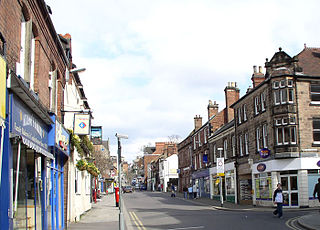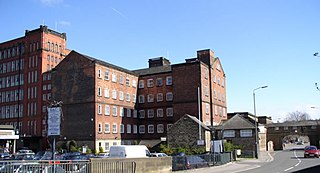
Derwent Valley Mills is a World Heritage Site along the River Derwent in Derbyshire, England, designated in December 2001. It is administered by the Derwent Valley Mills Partnership. The modern factory, or 'mill', system was born here in the 18th century to accommodate the new technology for spinning cotton developed by Richard Arkwright. With advancements in technology, it became possible to produce cotton continuously. The system was adopted throughout the valley, and later spread so that by 1788 there were over 200 Arkwright-type mills in Britain. Arkwright's inventions and system of organising labour was exported to Europe and the United States.

The Derwent is a river in Derbyshire, England. It is 50 miles (80 km) long and is a tributary of the River Trent, which it joins south of Derby. Throughout its course, the river mostly flows through the Peak District and its foothills.

Amber Valley is a local government district with borough status in the east of Derbyshire, England, taking its name from the River Amber. Its council is based in Ripley. The district covers a semi-rural area lying to the north of the city of Derby. The district contains four main towns whose economy was based on coal mining and remains to some extent influenced by engineering, distribution and manufacturing, holding for instance the headquarters and production site of Thorntons confectionery.

Belper is a town and civil parish in the local government district of Amber Valley in Derbyshire, England, located about 7 miles (11 km) north of Derby on the River Derwent. As well as Belper itself, the parish also includes the village of Milford and the hamlets of Bargate, Blackbrook and Makeney. As of the 2011 Census, the parish had a population of 21,823. Originally a centre for the nail-making industry since the Middle Ages, Belper expanded during the early Industrial Revolution to become one of the first mill towns with the establishment of several textile mills; as such, it forms part of the Derwent Valley Mills World Heritage Site.

Jedediah Strutt or Jedidiah Strutt – as he spelled it – was a hosier and cotton spinner from Belper, England.

Cromford is a village and civil parish in Derbyshire, England, in the valley of the River Derwent between Wirksworth and Matlock. It is 17 miles (27 km) north of Derby, 2 miles (3.2 km) south of Matlock and 1 mile (1.6 km) south of Matlock Bath. It is first mentioned in the 11th-century Domesday Book as Crumforde, a berewick of Wirksworth, and this remained the case throughout the Middle Ages. The population at the 2011 Census was 1,433. It is principally known for its historical connection with Richard Arkwright and the nearby Cromford Mill, which he built outside the village in 1771. Cromford is in the Derwent Valley Mills World Heritage Site.

The history of Derbyshire can be traced back to human settlement since the last Ice Age, over 10,000 years ago. The county of Derbyshire in England dates back to the 11th century.

Belper railway station serves the town of Belper in Derbyshire, England. The station is located on the Midland Main Line from London St Pancras to Leeds via Derby, a little under 8 miles (13 km) north of Derby.

Milford Tunnel is a double-track railway tunnel on the Midland Main Line in Derbyshire which runs under a hill called the Chevin between Duffield and Belper. It was built in 1840 by the Stephensons for the North Midland Railway. At 856 yards (783 m) long, Milford Tunnel was the second-longest tunnel on the North Midland Railway when it was built.

Ambergate is a village in Derbyshire, England, situated where the River Amber joins the River Derwent. It is about 6 miles (9.7 km) south of Matlock.

Milford is a village in Derbyshire, England, on the River Derwent, between Duffield and Belper on the A6 trunk road.

Belper North Mill, also known as Strutt's North Mill in Belper, is one of the Derwent Valley Mills, given UNESCO World Heritage Status in 2001.

William Strutt, FRS (1756–1830) was a cotton spinner in Belper, Derbyshire, England, and later a civil engineer and architect, using iron frames in buildings to make them fire-resistant.

Shottle and Postern is a civil parish within the Amber Valley district, which is in the county of Derbyshire, England. Sparsely built up with much rural expanse, its population was 270 residents in the 2021 census. The parish is 120 miles (190 km) north west of London, 9 miles (14 km) north west of the county town of Derby, and 2+3⁄4 miles (4.4 km) equidistant of the nearest market towns of Belper and Wirksworth. It shares a boundary with the parishes of Alderwasley, Ashleyhay, Belper, Hazelwood, Idridgehay and Alton, Turnditch and Windley.

Wyver is a locality within Belper civil parish, which is in the Amber Valley district of Derbyshire, England. The area takes up the western bank of the River Derwent just north of the former mills of Belper. Although overwhelmingly rural, the area has some notable associations within that industry and has been used for various activities throughout that time, and in recognition of these it has been made part of the wider UNESCO designated Derwent Valley Mills World Heritage Site.

The Derwent Valley Heritage Way (DVHW) is a 55 miles (89 km) waymarked footpath along the Derwent Valley through the Peak District. The walk starts from Ladybower Reservoir in the Peak District National Park via Chatsworth, the scenery around the Derbyshire Dales, and through the Derwent Valley Mills World Heritage Site. It follows the Riverside Path through Derby and continues onwards to the historic inland port of Shardlow. Journey's end is at Derwent Mouth where the River Derwent flows into the River Trent.
Belper is a civil parish in the Amber Valley district of Derbyshire, England. The parish contains over 250 listed buildings that are recorded in the National Heritage List for England. Of these, one is listed at Grade I, the highest of the three grades, 15 are at Grade II*, the middle grade, and the others are at Grade II, the lowest grade. The parish contains the town of Belper, the village of Milford, smaller settlements, including Makeney and Bargate, and the surrounding countryside. Industry has been a major feature in the town, initially with nail making, and some workshops have survived and are listed. Major industry arrived towards the end of the 18th century when Jedediah Strutt and Richard Arkwright built a textile mill in the town. Later, Arkwright moved away, and more mills were built by Strutt, and later by his sons. North Mill was built in 1804 by William Strutt, it was one of the first iron-framed and fireproof mills to be built, and is listed at Grade I. The Strutt family built housing for their workers in Belper and Milford, usually in the form of long terraces, many of which have survived and are listed. The family also built farms to produce food for the community, including Crossroads Farm, Dalley Farm, Wyver Farm, and Moscow Farm; the farmhouses and associated farm buildings are listed.


















